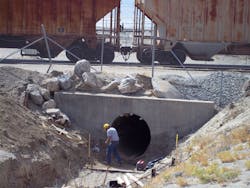Calif. mineral company re-lines damaged culvert under railroad
Many drainage culverts were installed 40 to 50 years ago and are now past their design life. They are failing at an alarming rate and causing roadway and railway damage.
One such culvert affected a private enterprise in Trona, Calif. Searles Valley Minerals was faced with a failing culvert underneath a railroad that delivers supplies to the company’s plant. The damaged culvert was a 72-in. corrugated metal pipe (CMP) that had a length of 120 ft. A failure of the CMP would compromise the structure of the railway and disrupt service of the rail line going into the plant. The company needed a permanent solution that would not disrupt the railway traffic or compromise the flow of drainage through the pipe.
Searles Valley Minerals had used a culvert lining system to re-line other damaged culverts affecting entrances into their plant. Since they were happy with the results of using that product, they wanted to use it again for this project.
The Snap-Tite culvert lining system is made of high-density polyethylene (HDPE) pipe. A patented male/female machining at each end of the HDPE allows the pipe ends to be “snapped” together, piece-by-piece, and pushed into the full length of the existing pipe. Generally, the pipe liners do not decrease flow even though the diameter of the original pipe is decreased with the liner in place. However, the county flood group wanted to make sure there would be no entrance losses.
To ensure they were in compliance with the county flood group’s flow requirements, the customer needed a solution that would allow them to use the culvert lining system and at the same time improve flow. An inlet control device was used for this purpose.
Independent testing conducted by Utah State University found that the inlet control device increases hydraulic flow by approximately 30%, compared to plain end headwalls under inlet control conditions typically found in culvert applications.
The mineral company’s crew worked quickly to reline the damaged culvert. The HDPE pipe was snapped together and inserted into the damaged CMP. To snap the pipe sections together, the crew did not need any special equipment and was able to use only a come-along and chains.
At the end, the inlet control device was also snapped on to the end of the pipe, creating a leak-free piping system. Grout was used to fill in any annular space between the old culvert and the new liner.
The whole time the crew worked, the rail line remained open and in use, so the company continued to use rail to send and receive materials. The culvert rehabilitation was completed quickly with no disruption.
